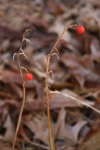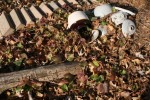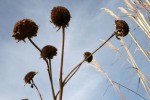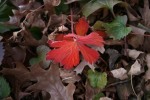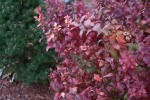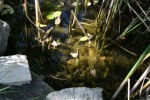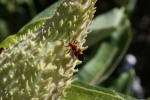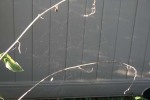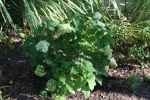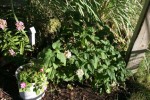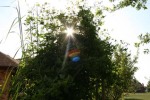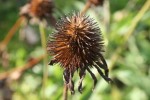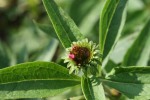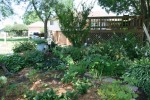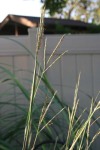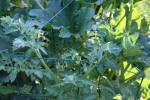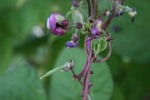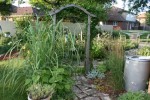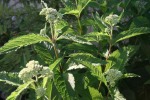Fairy Homes and Gaillardia Hopes
November 21, 2010
Thought I’d just take a stroll around yesterday and observe. Suffering from a cold, I wasn’t feeling up to putting away the windchimes or rolling up the hammock.
The hostas look like wilted lettuce left too long in the vegetable drawer, soggy and slimey. The lily of the valley leaves splay on the ground and their orange balls bounce above the mess. The speedwell is dry, like cinnamon sticks in the garden.
For a moment, I think that something has pulled apart a Damn Rabbit, as there is grey fuzz under my office window. I tense, looking for blood, and then realize this is the dirt out of my Dustbuster that I dumped the night before.
I feel sheepish.
The bellflower has done some seriously creeping on the berm this year; yes, it’s turning red, but in many places, it is still green and fresh. It seems to have covered a fairly large area this summer and it gives me another thing to look forward to next year. The garlic chives dry into castanets, their shiny seeds clattering in the wind, falling to the earth, to spread more garlic chive joy next year. Right now, the drying petals are delicate and transparent, amber colored and intricate.
And some of the flora are still growing. The alyssum is beautiful right now, healthy and sweet in the colder air. The sedum seems to be very confused, as there are fresh new petals emerging at ground level, underneath the yellowing stems and drying blooms. I tell them it’s not time, that they need to go back, but the oh-so-warm-for-November air has them at sixes and sevens and they can’t be stopped. The lamb’s ear is still sage green and fresh, the catmint actually reblooming.
I love catmint. It is the workhorse of the garden. One of the first up, one of the first to bloom, always coming back even after severe haircuts, staying at the party until the very last minute in autumn, trying so hard to hold onto summer fragrance, summer bloom – summer.
The prairie dropseed looks like fireworks, golden bursts on a deep green sky. More and more milkweed pods split each day – our friends the milkweed bugs have hosted their last orgy. The satin sheets and scented candles are stored away now until next year and they will drowse in hibernation, memories of those Bacchanal days drifting through their dreams, giving them impetus to survive until the spring.
The feathers on these seeds are just that – like feathers. They are soft as silk, like Griffey’s fur when he is cleaned and combed, like a stroke of a Damn Rabbit. I rub one between my fingers and it comes loose and floats away, the sun winking on the white feathers, flashes of silver and gold.
Some of the coneflower heads have been chewed open, exposing a teeny tiny hole in the raised seed head. What a great place to build a house! I can imagine a miniscule fairy, sprinkling twinkling dust along the outside, giving the pod a rehab before the move-in. What a cozy place, the fairy thinks. Just the right size door to pull my wings in after but keep the wind, rain and snow out. The round room inside is a perfect place to put up my feet, or roll into a ball, thinks this most indolent fairy. And what good fortune! Several of these space all together! I can use one as a bedroom, one as a store room for seeds to eat through the winter – I’ll be as snug as a bug in a rug.
While these fancies take me over, I notice the gaillardia seed heads are in the same phase – drying and falling apart.
I have promised myself I’m only observing. I don’t want to aggravate this cold.
I grab a bucket and start cutting heads – nearly dry, really dry and everything inbetween. There are dozens and dozens, more than I thought on initial glance. They fall into the bucket with small dull thuds. I gather quite a bunch, then head to the front, to the bed with the Siberian iris and the new butterfly bush. I stand back and look at the bed, at the empty spots between the iris, next to the peonies and around the butterfly bush. I see in my mind’s eye the contrast of the white peonies with the purple iris, then as that fades, the purple chaos of the butterfly bush complemented by the unbridled havoc of the gaillardia. Oh, how sweet!
I indicate eight spots where a gaillardia should emerge and then begin digging. I hit no bulbs in the first hole and throw in a handful of seed heads. The same goes with the other seven holes, a first in autumn planting.
This is just a hope and a garden prayer. I’ve done this with coneflowers and reaped fantastic results, but I don’t know if the same will be true of gaillardia. I’m hoping that since it’s a prairie plant, since the seed heads dry, droop and decay, it will be the same. I’m hoping that the squirrels don’t dig them up, that mice don’t find them, that they don’t freeze beyond hope of germination in the ground this winter. I’m hoping that they sprout in the spring, that they grow and that they bloom.
I’m hoping.
- lily of the valley
- hostas wilting
- speedwell dried blossoms
- spotted bellflower creeping over the berm – watch for the leap next year
- hostas in the sun
- prairie dropseed fireworks show
- purple liatris
- milkweed seeds
- horsefly sunbathing
- peonies and the growthrough grid
- peony leaves
- sunflowers and pampas
- the storage bin?
- proper home for a fairy
The Garden Ablaze
November 10, 2010
Red, red and red everywhere in the garden today! It seems as if a wildfire is silently, slowing burning – but with furious color and heat – every few feet in the garden.
The spyrias have all gone up in flames, but differently. Some are really crimson, some nearly pink, some almost purple. Seeing as they are nearly all the same variety, I must attribute the color differences to how well the soil is amended in each spot, the angle and amount of light they receive each day, and how close they are to the house. Closer to the house means the soil stays warmer all winter long which could certainly affect the color show.
The coral bells are still mostly green, a rich forest, then a blinding blast of bright orange here and there as a leaf turns. The wild geranium tends to be like this too, airy green leaves drying and then FLASH! A pop of red to surprise and delight. While the native foxglove is known to just wither and disappear, suddenly there is a unique cluster of leaves, cranberry against the dirt.
The barberry, burgundy all year, is suddenly awash in garnet, bright and vibrant against brown grasses and drying garlic chives.
The anemone leaves are turning too, from deep evergreen to bright burgundy, some leaves looking tie-dyed as I catch them in the middle of their change. The sedum truly looks like a bonfire, with yellow stems and leaves reaching out like flickering fire, topped with claret blooms.
Yesterday, while I was gone, more than 200 pieces of firewood were delivered and dumped on our driveway. Tony wheeled load after load and piled them neatly along the side of the house. Griffey was probably wild with anticipation of evenings lolling in front of the fireplace, toasty warm on my lap.
While the garden is shades of fiery red now and will turn brown in weeks to come, that mix of oak and birch is now brown, with the orange, yellow and red yet to come.
- garlic chives and spyria
- barberry bush
- geranium
- foxglove
- spyria
- spyria
- spyria
- coral bells
- yes, lots of spyria
- anemone
- firewood stacked for the season
- sedum
Last Gasps and Ginormous Spiders
September 29, 2010
No rain again today and the garden is starting to feel badly for it. I turn on all three hoses, laying the back yard hose by the first of three hydrangeas, connecting the side hose to the soaker hose in the vegetable garden and putting the front hose on one of the two hydrangeas. I did not know hydrangeas were such water hogs. I have already promised them I will do better next year.
I set a timer.
The turtle is now down to a lop-sided spit, as leaves and algae start to get the better of the pumps. The waterfall drips. The gurgler is the only thing still pumping full force and it effects the sound of the pond. Instead of a medley of splashes and tinkles, the only sound is almost that of a faucet splashing into a sink or tub. The melody is gone.
The peas have begun to sprout, barely showing new-green heads under the mulch of dry grass. The beans are tall and healthy. The tomatoes continue to ripen and the brussel sprouts confuse me. They are not yet large enough to harvest, but have been growing since May. I do see some real difference in the stalks, so perhaps this is the same kind of growth as the sedum. The sedum is one of the first plants to emerge in the spring, putting little flat paddles of green in rosettes out into the sunshine. They are one of the last plants to bloom, and they last well into fall and the beginning of winter.
There are pops of color in surprising places. Not only has the purple clematis given us two beautiful blooms, completely unexpected and untimely, but a coneflower suddenly seems to think it’s July and has put out buds, blooms and new blossoms. A zinnia has come from out of nowhere and given me three fresh-faced bright pink flowers, like buttons all in a row. The red hibiscus exploded with one more hurrah, a bright red umbrella.
A red dragonfly buzzes past me in the back, hovering, zipping, hovering and zipping away. The milkweed bugs are scarce, only three on a milkweed pod that sits in the very bright sun.
The sun itself is different now. The angle to the earth is different, which means that suddenly, the trees in the parkway cast shadows on the front beds. Those trees are turning yellow, dropping leaves that float to the ground. The honey locust shed small brown leaves that curl into a bowl, and those are like confetti. They are everywhere, sticking to shoes and dog paws and tracking into the house at an alarming rate.
Coming along the weglia path, I notice a huge, giant, out-of-this-world spider. The nearest identification I can get is an orb spider. This sucker (get it?) is enormous. Her body is easily the size of my thumbnail, and with legs spread she could span a quarter. The web is a chaotic mass of silk, an orb weaver inebriated. She has sadly attached this web to our garbage can, so Miss Spider will only keep her home until Friday morning, when that can is wheeled to the sidewalk. I wonder if she will consider that a temporary loss and come back to rebuild in the same spot.
There is also another monster in a web built within the dried stalk of a hosta and a container on the berm. This resident is much shyer and bounces along the web to curl into a ball on the stalk, now seemingly invisible to me.
When the timer goes off, a raucous car horn, I am momentarily confused. For a split second, I’m not quite sure why it’s set. What was I supposed to do again? I remember, move the hoses and set it for another twenty minutes. And then I do it once more.
After that final alarm, I turn off the hoses and roll them up. Then I walk around the house one more time, to make sure I really remembered them all.
- lop sided turtle spit
- algae in the pond, sunshine
- tomatoes!
- full veggie garden
- butterfly bed
- fall clematis dying back
- unexpected hibiscus
- unexpected zinnia
- stoic milkweed bug
- unexpected coneflower
- We love you spider…
- big web, big spider
- another big web!
Questions, Questions, I Have Questions!
September 8, 2010
The hydrangeas that cried wolf are back, looking healthy, fit and fine. I thought impatiens were overly histrionic but their thespians skills pale in comparison to their hydrangean brethren. The angst they’ve caused, with their wilted leaves, drooping flowers and sagging stems was completed unfounded. They are the undisputed prima donna of the garden. And after several weeks of being planted, seeming to be very pleased with their spot, did they chose Tuesday to look so sickly?
It’s chilly today and all the fish swim at the bottom of the pond, where I would think it’s actually colder. With their little insulated lives, born and raised in domestic conditions, do they have any instinctive inkling of what is to come for them? These 27 cent fish have grown large and hardy; they would be in the 99 cent tank now. If we have a mild winter, they could certainly survive until spring. That has happened before, causing me a great deal of shock come March as gold streaks zip within the dead leaves and paper that collect in the pond.
There is a beautiful spiral orb web between the cattails over the pond. It is not a neat web, as it seems to have been mended many times and has bits of insect still stuck in its threads. Spiders are so strategic in their web placement. Is that instinctive or is that educated behavior? Does this particular spider hope to catch the no-see-ums that swarm over the pond or is it hoping for a fish?
Only three punks total this year – a disappointing harvest.
The clematis on the arbor opens more and more, with the scent of sweet, sugar, honey hanging in the air. This plant gets less sun than its fellow on the front trellis and yet has more blooms open already. They were planted at the same time, from the same nursery in the same size pot. Given the fact that clematis likes full sun, why would the early bloomer be the one in less than ideal conditions?
Which kid at the party caused a cave-in on one of the pond banks?
The drying gaillardia holds a surprise. I took it in my fingers and rubbed. Instead of being dry and crackling, the petals feel like worn tissue, soft and supple. Will these reseed? Can I get volunteers? Should I gather seed heads and plant them in the front beds like I do coneflowers? I am reading that I can, so I will give that a try.
The coneflower pink fades to black as the sedum green bursts into pink. The sedum draws bees and flies and butterflies, a friendly plant. The zinnia are confused. Some dry and fade to brown, some bloom deep red.
Now the purple clematis in front is truly covered with truffula trees, with the seed heads now gone to complete Thneed raw material. Those whirly fans have started to bloom feathers, turning into ecru balls of tuft. They look like wild cotton balls.
A flock of finch peep and beep and whistle in the trees in front, fluttering from one tree to the other and back again. These birds are more shy than robins, tentative around people, and are anxious to get back to their meal, a cluster of coneflowers. They have a question of their own:
When the hell is she going to get out of here?
- recovered hydrangea
- recovered hydrangea
- orb spider web
- gaillardia
- pond slide – damn kids
- peppers!
- coneflower eaten by a finch
- butterfly weed seed pod
- sedum
- clematis
- coneflower
- clematis seed head, now a Thneed
- Jeff Goldblum on the seed head
- stages of zinnia
- pampas grass fuzzing out
- pampas grass, pin oak and blue sky
Hydrangea in Crisis
August 25, 2010
Dominic and I finally fixed the garage hose reel last night – fully and completely. It required drilling, unscrewing, screwing, a trip to the garage attic and a lot of agitation and aggravation on his part. We are night owls together, he and I, but sometimes my projects don’t mesh with his projects. I think of late night as time to get things accomplished – painting the house, cleaning closets – and he believes late night is for technology – computers, movies and video games. We did manage to get it done with a minimum of angst and I was able to water the butterfly bushes this morning with no leakage and a smooth roll out and roll up of the hose.
This morning was a taste of fall. We still have about four weeks to go before it’s official, and the autumnal equinox doesn’t immediately bring chilly weather, but today was definitely a moment. Fall is my favorite time of year. It means apple picking (which means apple pies), fires in the pit, bursts of color and of course, Halloween, the most fun day of the year.
I watered the front garden this morning, pulled a few weeds and dosed the weeds with vinegar. The balloon flower was deadheaded and continues to amaze me. It’s been blooming for months now and while it is slowing down, there are still buds and balloons preparing to bloom. This may keep up until Labor Day!
This afternoon, I walked outside to make photographs and was confronted by a devastating site. One of the new hydrangeas was wilted and drying, looking past diva stage and well into terminal. My god, how can I have been so lax? How did I not see that this morning? Because I was too busy watering in the front, that’s how! And now my hydrangea is suffering for my lack of attention!
I attached the wand (I love the wand. It puts out such a beautiful spray of water and is just so handy) and soaked it well. The ground sucked it up and sucked it up and when I moved away to water a container, it was dry within seconds. I gave the impatiens a shower, gave the other hydrangeas a good bath and then came back the first hydrangea.
That was when the little grey mouse scurried through the flower bed between the speedwell and the coneflower. Oh, gracious.
The hose was propped up so the water sprayed at the hydrangea’s roots and I started around the house.
The garlic chives are blooming. Stand in certain places in the garden and they seem like waves of stars or drifts of snowflakes. The foxgloves are giving us a burst of color late in the season. The grasses bloom, the pampas grass sending huge fireworks of white high into the sky. The sedum begins its own burst of stars, pink here. The gaillardia begins to dry and look like a fall flower, brown and yellow.
We got one more dinner out of the purple runner beans tonight, but as I picked them, the vines came loose from the ground. The beans were not as delicate, a bit chewy and heavy in fact. Tony did not eat any. He is fussy about his vegetables.
The waterfall is not. I’m wrestling with purchasing a new container for that whole set up – something taller, with a tulip shaped lip so the water will pour and splash over more than just flow. The pond rebuilding is not the Most Fun Job for me, so I think I’m subconsciously throwing up roadblocks, posing dilemmas, to put off the inevitable. Question – if you figure out you’re doing it, is it still subconscious?
My experiment with the coneflower in front is not pleasing. All that time spent carefully deadheading and I didn’t get enough of a second wave to make it truly worth it and I’ve denied myself alot of seed heads that I could plant in other spots in the garden. There are enough, though, for the finches. I’ve seen them already. They come after the butterflies, when the nectar is gone and dried and the seeds stand tall and crisp and tasty. The finches grip the stems and rip the seeds from the heads in a joyous feast.
Thank heavens they’re not eating the butterflies.
The watermelon is caved in on itself and looks like nothing so much as a deflated plastic playground ball. The tomatoes continue to ripen into tasteless mush. This plant was free at the Farmers Market. You get what you pay for. The green peppers are like a younger sister when the older one leaves for college – suddenly blooming, suddenly growing, suddenly interested in the sun and the water. There are baby peppers everywhere and more blossoms. I will not plant watermelon again.
I head back to that sad hydrangea and it is still pathetic. The ground is wet, soaked in fact. The mouse scurries again, soft and grey. I pick up the hose and given the compost bin a thorough soak. Where there is one mouse, there are probably more. The compost bin has a new insect resident; fat big black ants. Is that because there’s a banana in there? Or is it just Big Black Ants In the Compost time of year?
The hose goes back by the hydrangea and another dose of water is administered. I’m watching but I don’t see much improvement, no rising from the death bed. I test a stem and there is still plenty of flexibility, plenty of life, so I think it’s just a matter of time for it to recover. I turn off the water but leave the hose lying there, like an IV I can turn on at a moment’s notice. I will check first thing tomorrow morning and go into medic mode if necessary.
That damn thing better recover.
- garlic chives
- sedum blooming
- foxglove – what a great color!
- Hydrangea needing help!
- view of the pin oak bed
- isn’t this COOL? sunshine through the fall clematis
- pampas grass
- pampas blooms
- balloon flower still chugging along
- coneflower drying
- and another coneflower
- rabbit browse on the lobelia – why do I plant these?
- scabiosa finished
- pod splitting
- really like a alien world, isn’t it??
- Poor Ebenezer
- last of the runner beans
- Tony doing his crossword puzzle
- water not fall
- runner beans!
- last of the bean vines.
Giving Goldfinch Grief
August 6, 2010
The mystery plant in the pin oak bed has revealed itself! It’s acorn squash and there are two sitting like twins (or breasts if you are so minded) in the dirt, green and round. I am very pleasantly surprised. This vine is the result of an acorn squash tossed from the back door last fall, then covered with that new black dirt and rotting throughout the winter. Just like the potatoes we enjoyed last week, it’s an unexpected plant in an unexpected place, showing how well the earth works to rejuvenate itself and feed its inhabitants.
Acorn squash is a vegetable that I enjoy and no one else, rather like peas. While I can understand that acorn squash might be an acquired taste, I can’t understand my family’s rejection of peas. It seems such a unobjectionable vegetable, rather like the world’s green corn. I make a lonely handful for myself every now and then and am unsure why I am compelled to put them in a serving bowl on the table instead of just on my own plate. That would save everyone pea angst and save Tony from washing another bowl.
The sweet potato vine has pulled a complete coupe over the containers. There is virtually no sign of other annuals save for one struggling, pathetic dried out attempt at a geranium blossom. And you have to really search to find that. This is a case of being careful what you wish for, as when I noticed these in containers last year, I had sweet potato vine envy. I will carefully reconsider using these again next year. I think it comes down to the fact that I just can’t seem to do containers. My mom’s are lush and full and colorful, with all the plants complementing each other in size and shape. Mine were planted with geraniums and impatiens and lobelia and spikes and sweet potato vine. I now only have the vine. I think I need to admit container defeat, or just embrace the chartreuse majesty and let the geranium sorrow go.
After the total cut back that I gave the oregano weeks ago, it is blooming again, making those bees and butterflies so very happy and full. The sedum is about to burst into bloom as the coneflower revs up for its second, somewhat smaller coming. The stems are shorter, the flowers are smaller, everything is more petite and pint sized. The butterfly bush needed to be deadheaded again and that’s a tricky one. It grows with the flowers in ever-repeating tridents, with the center flower the biggest and first to bloom, first to die. Those spikes must be carefully cut out of the middle to preserve the buds on either side – again and again and again. It is one of the more tedious jobs in the garden, but well worth it with each rebloom.
The trumpet vine keeps insisting on growing right on the bricks, behind the lattice where it cannot be seen. I keep pulling it back out and am trying to think of ways to keep it where it belongs – or where I want it to belong. Perhaps I need to slide a sheet of wood behind the trellis to eliminate the space. Or maybe the vine just needs to be moved to a better spot and another clematis planted there. Unfortunately, I can’t think of a better spot. Maybe in front of the porch, winding up the pillars?
Jacob Marley the watermelon is troubling now. The front is smooth and beautiful but deceiving. The back is marked with scratches and has several splits. I hope they are healing from the inside and we can still enjoy this come fall. Danny will be disappointed – and so will I – if it’s ruined.
I sat on the groovy flower bench during prime feeding time for the goldfinch, about 6 feet away from the feeder. My goal was to sit very quietly and still and when they landed on the feeder, make plenty of beautiful photographs. They were on to me. I heard plenty of finch calls and saw much dipping and flipping of wings as they prepared to land. Then I saw them scutter in mid-air when they saw me. They wheeled back up, flew in a wide circle around the feeder and would land in the pin oak above me, beeping their distress. Not one was brave enough to land on the feeder. When I realized they weren’t giving in, I did. I hated to ruin their dinner.
I know they’ll fly in when I’m on the patio, a good 15 feet away – wimps.
- sunflowers about 5 feet tall
- sunflower bud
- one lone tomato on the upsey daisy – what a JOKE
- sweet potato vine
- can you find the geranium? poor thing…
- oregano second wave
- hibiscus before deadheading
- coneflower bud
- sedum
- butterfly bush before the snip…
- …and after
- grass by the rain barrel
- Eliza’s gazing ball at sunset
- acorn squash
- roma tomatoes
- salad greens making a (small) comeback
- watermelon with hidden splits
Lazy Grasshopper Days
July 18, 2010
A long weekend with many family events precluded any real time spent in the garden, but there were a few things of interest…
Saturday, I got up to a dramatically changed backyard as our neighbors had pulled down their whole fence before 8 am. Because the dogs chains are long enough to go into their yard sans fence, I put on my pink cotton muumuu and headed outside to make sure Griffey didn’t take a chunk out of somebody’s calf.
My pink cotton muumuu started as a joke. When we were in Florida, I used my mom’s because I had forgotten a robe. Well, I loved it. Big and airy and all covered up, zippered so it wasn’t gaping open all the time. It was a laugh in Florida and then when my parents came home, my mom headed to Wal-Mart (shudder) and bought me one. Eliza laughed and laughed and then was very afraid because I was really glad to have it. I use it in the morning and to curl up at night and watch movies. It is still a joke, but a very useful one.
My neighbor and I talked across the yard about the fence, about our kids, about their growth and her impending empty nest as her youngest just graduated from high school and will attend school out of state. They lost a son two years ago and she said she feels that now, they have reached the new normal for their family. Sometimes, talking to people who’ve lost children, I feel obscene – and so fortunate. The Black Hole could easily have swallowed Dominic entirely and while the fight was long, ugly, slow and painful, he was pulled back from the abyss. He now survives, more and more whole each day. While our family has been damaged in many ways, we will be able to heal, and we are always able to hold him, laugh with him and watch him grow. Through all the horror, we are blessed.
A new fence would go up by the end of day Saturday, although we were not around to watch its progress. Saturday night, I walked out onto the patio to see how nice and tidy, new and clean, it would look. Both my eyes with the fence and my nose with the fragrance were delighted. The scent of all the flowers, especially the lilies and the gaillardia, hung heavy in the hot, wet, still air. The fence is still the stockade type (sigh) but now it is straight, undamaged and attractive.
Today, I noticed the monarch butterflies have begun feeding from the milkweed and the liatris. They seem to float on the breeze, seemingly rudderless. Then they surprise you with a sharp turn or a quick dive, apparently in complete control all along. Friday, I bought windchimes at the grocery store, noticing them while looking for bug spray. A pink one with butterflies and ribbons (which really captures the mood and feeling of a butterfly) and a blue one with steel birds now hang on each side of the ridiculous, waste-of-time tomato planter.
This evening, I noticed that the heat had wilted many things but I was in a very lazy mood, probably brought on by that heat.I attached the house hose to the garden soaker hose and turned it on, watering the veggie garden and perking everyone up. I put my sprinkler attachment on the hose in the back garden and doused the impatiens, the lilies and the hibiscus.
A big brown grasshopper leapt out of the impatiens and came to rest on the sedum as I watered. Droplets trickled from his antenna and his legs; he was much annoyed.
As a child, in late July, the south side of our house would be covered, just covered in grasshoppers. Every day, every year. My brother Rich, neighbor Dawn and I used to sit there with huge glass jars that smelt of salt and vinegar we’d salvage from Grandma’s basement. (Dawn was a guilty secret from the nuns, as she didn’t attend Catholic school, but we so liked to play with her -same age as me and right next door! Such temptation! We had no choice but to be led right into it.) We’d fill those jars with twigs and grass and punch holes in the lids with a nail, always hoping to shape the opportune size of opening; just enough for air, but small enough so the grasshoppers (and later in the evening, the lightning bugs) couldn’t escape.
Then we’d wait until the bricks were bathed in sun, hot and dry. That’s when the grasshoppers would come, to bask in the heat. They were so easy to catch then. Drugged with sunshine, they moved slowly if at all as we cupped hands around them and dropped them into the jars. The goal was always to find and catch the biggest one. We’d wrinkle our noses about the “tobacco juice”, brown and sticky and next to impossible to wash from our fingers. Every morning, no matter how small we’d made the holes, the bugs were gone.
As to the stockade type of fence, I am undecided. On the one hand, they are unfriendly and confining, sealing you into your yard and away from your neighbors. On the other hand, they give you privacy and allow you to run around in that pink muumuu without repercussion.
Now that I think about it, Grandma and Grandpa always seemed to have a vast supply of huge glass jars on hand. They must have eaten alot of pickles.
- No fence!
- A weird and temporary reality
- The berm looks lost, floating unanchored
- Had a chance to pull weeds back there and there were none – how nice!
- phlox
- turkey foot
- watermelon
- dragonfly
- grasshopper on sedum
- wilted and now doused impatiens
- stargazer lily
- new fence – like nothing changed
- balloon flower
- new windchimes
- sweet potato vine taking over
- fall clematis
- zinnia in bloom
- liatris
- spiderweb by the veggies
- tomato plant
- zucchini leaf in the sunset
- hosta leaf in the sun
Swelling Watermelon and Laddered Panty Hose
July 9, 2010
Old panty hose come in handy in the garden in so many ways. Many use them as plant tape to tie up peonies, to attach spindly stems to supports and to just keep things neat and tidy.
I am fishing a laddered pair out of the garbage to tie up my watermelon. It is the size of a softball now, and seems to be growing before my very eyes. I am thinking that the weight as it grows will be too much for the vine and it will snap off before it is really ripe. Tomorrow, I will make a nylon cradle that I’ll tie to the chicken wire in the hope of staving that off as long as possible. There is another one about the same size nestled below the leaves and sitting on the ground, many about the size of robin eggs and covered in hair and still more dozens of yellow blooms. I’m wondering how many will turn into fruit.
The purple runner beans are an interesting phenomenon. Fuschia blooms, then green “Barbie” beans and then suddenly all purple, with a green inside. I should have enough for a meal by Monday. Today, we were able to get another meal of the regular green beans. They are picked, in the pot and on the table within 15-20 minutes and that is the very definition of fresh, don’t you think?
The zucchini is scary. They are like the loaves and fishes – they never seem to stop. The leaves are enormous, like something out of the jungle. They are covering up the tomato plant and the beans on that side of the garden, so today I clipped back about five of the stems and leaves to give the other plants more sun. Because those stems are hollow, when I cut them it sounded like a champagne cork popping. What fun! And for even more fun, I put those leaves onto the fence supports, like a tube over a pipe. The Damn Rabbits are probably wondering what that is all about.
The green peppers are swelling and we should have some ready to make summer salad on Monday. That’s my great grandmother Streit’s recipe. Very simple and very delicious – and perfectly named.
Summer Salad: Cut up tomatoes in chunks, green pepper in chunks and onions (my mom chunks, I have a tendency to dice). Put them all together in a bowl, sprinkle with a pinch of sugar, about 1/4 teaspoon, and set it aside for about an hour or so. Then refrigerate just until cold. Sooo good with hamburgers, steaks, ribs, you name it. The perfect summer salad. Get it?
The brussel sprouts get taller and taller with those tiny sprouts all along the stem. I am having such fun watching them.
The butterfly garden is recovering from the deadheading and the milkweed just keeps on blooming. I don’t think I like the cinnamon fern after all – it’s just a big huge brown thing at this point, so I may pull that out this weekend. The balloon flower is just covered in blooms, soft and pink, starry and delicate. It needs to be deadheaded nearly every day, as those blooms are short-lived. They burst into beauty and then are gone.
The grasses are blooming and the turkey foot is just splendid, with tiny red and gold seed pods like stars twinkling in the sunlight. Experimented with the Eupatorium, big brother of the Joe Pye Weed. It’s recommended to cut them down halfway before they bud out to get more flowers. Well, I cut down about half the stems and left the others to just grow. The stems I cut branched out to four or five stems and each stems has buds. But they are smaller than the buds on the stems I let grow. Should I have cut them back earlier? Or it that how it works?
The hibiscus are budding, the old phlox are budding and the new phlox, monardia and ligularia need watering. The pond plants are growing, the cypress tree edging over my neighbor’s fence. When I bought it about six years ago, it was about 10 inches tall. Now it is about 6 feet tall. That’s pretty rapid growth for a tree. The sedum is setting buds, like green snowflakes covering the flower beds.
I wanted to name Eliza Francesca after Grandma Streit (she was Frances) but that got voted down. Soundly. Now I think that worked out for the best. A Francesca needs to have very long mahogany hair and sultry chocolate eyes (Dominic, if he were a girl, would have made a good Francesca). Eliza has a blonde bob and snappy green eyes. Eliza is happy about it too, really enjoying her name. Except for that year in preschool when she told everyone she met that her name was Cinderella. A lot of uncomfortable smiles and frozen faces until they saw me silently shaking my head behind her. While it was such fun to enjoy her imagination, it was also very awkward and I didn’t know whether to be disappointed or relieved when that particular phase was past.
I decided on relieved.
- Watermelon not so hairy, but bigger and bigger
- Purple runner bean, now green
- brussel sprouts
- The mad zucchini
- zucchini leaves “unfurled”
- The butterfly garden
- Liatris
- upside down tomato – never again
- balloon flowers
- backyard
- hibiscus
- grasses
- stargazer buds
- eupatorium cut back and regrown
- eupatorium left to grow uncut
- turkey foot grass
- old phlox
- pond plant
- sedum like a snowflake
